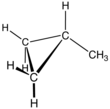| |||

| |||
| Names | |||
|---|---|---|---|
| Preferred IUPAC name
Methylcyclopropane | |||
| Identifiers | |||
3D model (JSmol)
|
|||
| ChemSpider | |||
| ECHA InfoCard | 100.008.934 | ||
| EC Number |
| ||
| MeSH | C105498 | ||
PubChem CID
|
|||
| UNII | |||
CompTox Dashboard (EPA)
|
|||
| |||
| |||
| Properties | |||
| C4H8 | |||
| Molar mass | 56.108 g·mol−1 | ||
| Appearance | Colourless gas[1] | ||
| Density | 0.6912 g/cm3[1] | ||
| Melting point | −177.3 °C (−287.1 °F; 95.8 K)[1] | ||
| Boiling point | 0.7 °C (33.3 °F; 273.8 K)[1] | ||
Except where otherwise noted, data are given for materials in their standard state (at 25 °C [77 °F], 100 kPa).
| |||
Methylcyclopropane is an organic compound with the structural formula C3H5CH3. This colorless gas is the monomethyl derivative of cyclopropane.
Reactions[edit]
Methylcyclopropane, like many other cyclopropanes, undergoes ring-opening reactions. Bond cleavage in certain reactions is also reported in conjunction with the use of methylenecyclopropane groups as protective groups for amines.[citation needed]


Well, that’s interesting to know that Psilotum nudum are known as whisk ferns. Psilotum nudum is the commoner species of the two. While the P. flaccidum is a rare species and is found in the tropical islands. Both the species are usually epiphytic in habit and grow upon tree ferns. These species may also be terrestrial and grow in humus or in the crevices of the rocks.
View the detailed Guide of Psilotum nudum: Detailed Study Of Psilotum Nudum (Whisk Fern), Classification, Anatomy, Reproduction